Koi fish are world-famous for several very good reasons. They are large, showy fish that are easy to care for and live for a very long time.
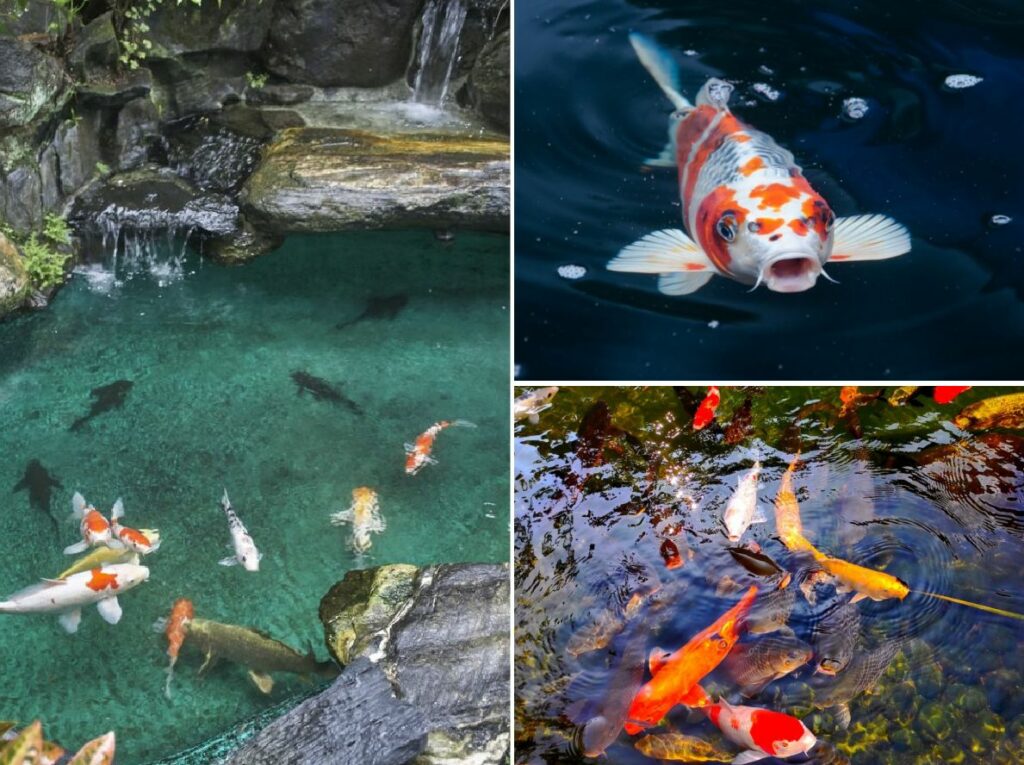
The types of koi fish have a literal blizzard of names and labels that can be confusing to understand if you are not way into koi fish culture.
Fortunately in this article, I will take some time to explain the history of koi fish. As well as the different types of koi fish and how to care for them!
The History of Koi Fish
There are hundreds of types of Koi around the world today! And every single one is descended from the There are hundreds of types of Koi fish around the world today!
And every single one is descended from the Amur Carp, Cyprinus rubrofuscus, bred in Japan for color nearly 200 years ago. Before then, Amur Carp were primarily a food fish, raised in koi fish ponds across Asia for thousands of years.
However, an enterprising Koi fish breeder in the town of Ojiya in Northeastern Honshu started selecting for beauty instead of just taste. Many types of Koi fish now have collector’s value; these koi fish cost thousands of dollars because they are valuable as aesthetic and breeder specimens!
Because there are so many different types, and because Koi are both sold mixed and hybridize regularly, I thought it best to break down the different types of Koi fish so you can choose varieties that best suit your personal tastes.
Basic Koi Fish Terminology
Koi vocabulary is intensive, going so far as to have individual names for each of the different color blobs Japanese koi fish vocabulary is intensive, going so far as to have individual names for each of the different color blobs on a particular fish! In this not so brief breakdown, these are the Japanese words you may come across on a frequent basis.
- Nishikigoi: True Koi Fish
- Hirenagagoi: Butterfly Koi Fish
- Gosanke: the “Big Three” – Kohaku, Sanke, and Showa
- Doitsu: Scaleless (also may have large mirror-like scales)
- Hi: Red
- Shiro: White
- Ki: Yellow
- Sumi: Small black markings along the back
- Tejima: Scattered black markings on the pectoral fins
- Gin Rin: Koi with modified scales. May have depressions or raised scales that resemble pearls.
Common Types of Koi Fish
1. Kohaku
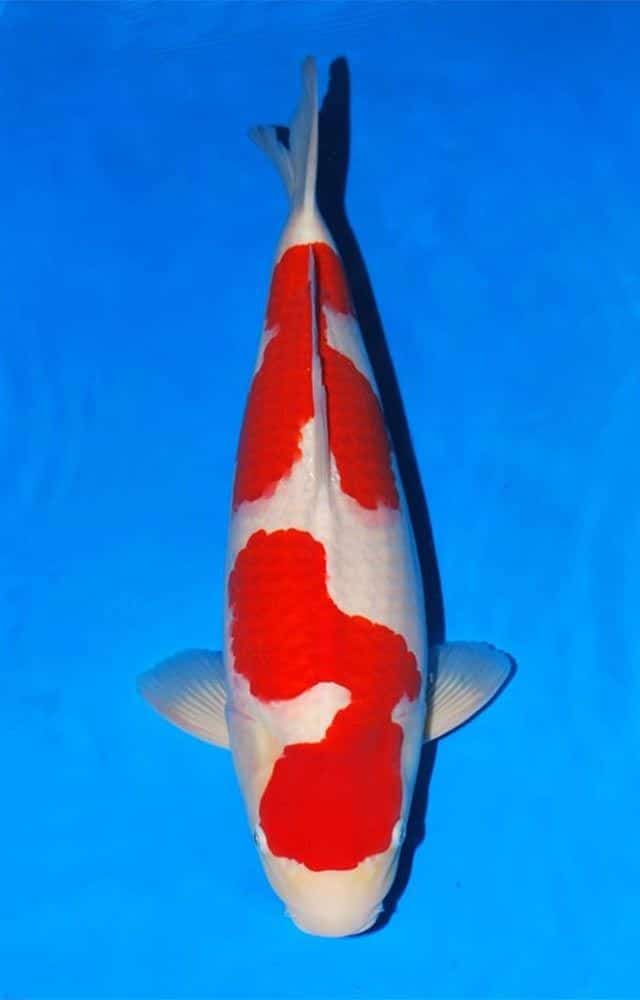
It is said in the ornamental Koi tradition that Koi fish keeping begins and ends with Kohaku. When you think of Koi, these are often the fish that come to mind. As one of the Gosanke, the Big Three, along with Sanke and Showa, Kohaku are immensely popular types of Koi. Kohaku have white bodies with red markings and no additional colors.
- Top quality Kohaku should have a red spot on the head. Kohaku without are known as bozu, which references the shaven head of Buddhist monks.
- Thought to originate in 1888 and is still one of the most popular types of Koi Fish in Japan.
- Kohaku have several secondary descriptions for their red markings; a Kuchibeni; lipstick, refers to a facial mark that extends to the mouth (not favorable) while an Ōmoyō has a mark larger than a quarter of the length of the fish. As it matures, the markings will extend and transform.
2. Taisho Sanke
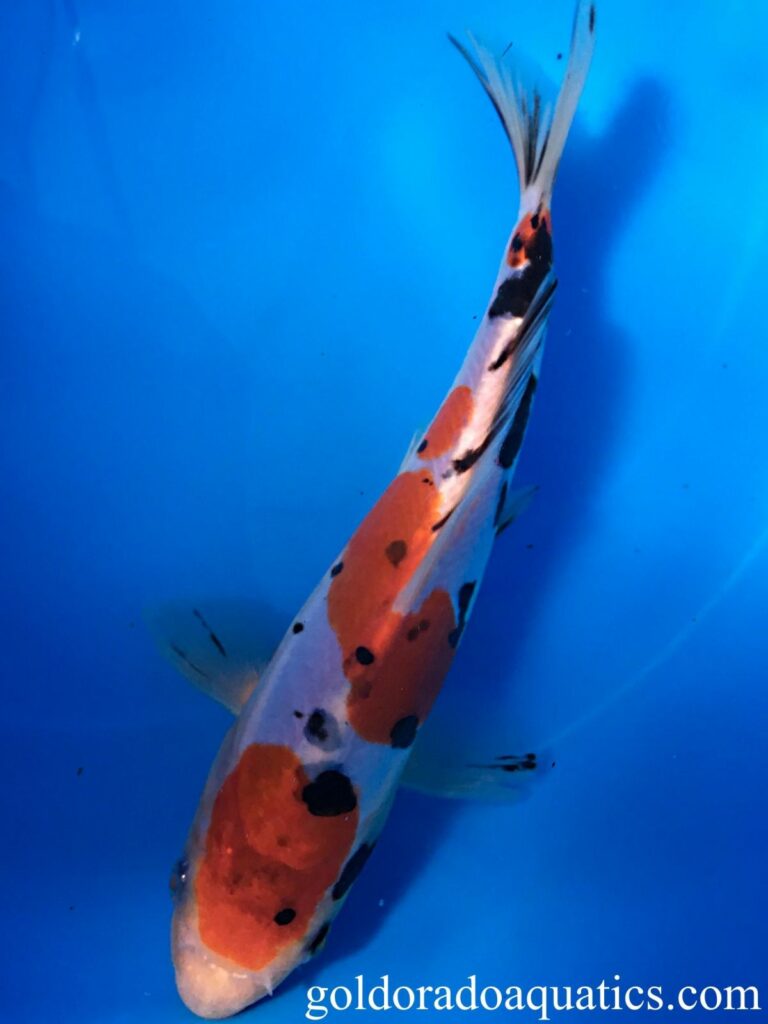
The origin of the Taisho Sanke (most formally known as Taisho Sanshoku) is supposedly a matter of happenstance. During Japan’s Taisho era, 80 years ago, a Kohaku with small, scattered black sumi markings appeared among the breeding stock. Like Kohaku and Showa, Sanke are one of the Big Three of the Koi world. Gosanke of the best quality have a snowy white base and crimson red markings.
- While Sanke follow the rules of appreciation for Kohaku, a few scattered black markings (tejima) on the pectoral fins are favorable.
- Black sumi should follow a stepping stone arrangement along the back of the fish, while remaining above the lateral line.
3. Showa Sanshoku
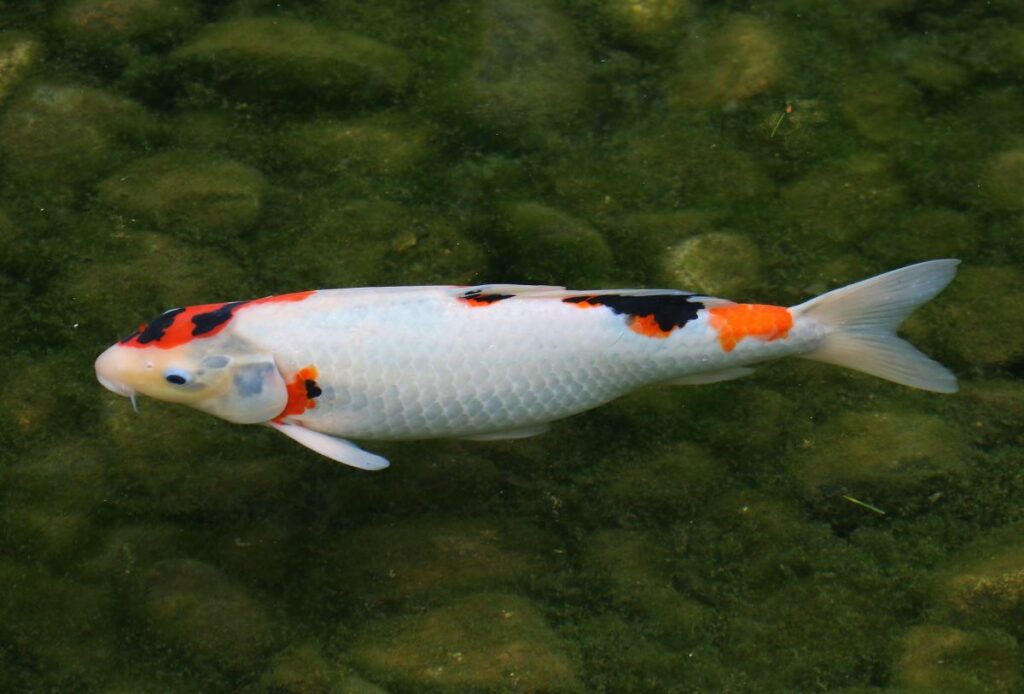
Showa Sanshoku are black bodied with red and white markings. The third Gosanke was developed from crossing two varieties in the 1920’s but wasn’t fully developed until the 1970’s. Unfortunately, unless you’re buying from a koi specialist breeder, its hard knowing for certain whether you have a pure Showa or Sanke.
- Showa and Sanke are easily confused; Showa are black-bodied fish and can have black patterns anywhere. Sanke only have black sumi patterns and never have black on their heads.
- While both are descended from Kohaku Sanke tends to have more prominent red markings than Showa.
- An even distribution of color between red, white, and black, with a clear distinction between the color boundaries is considered ideal.
4. Koromo
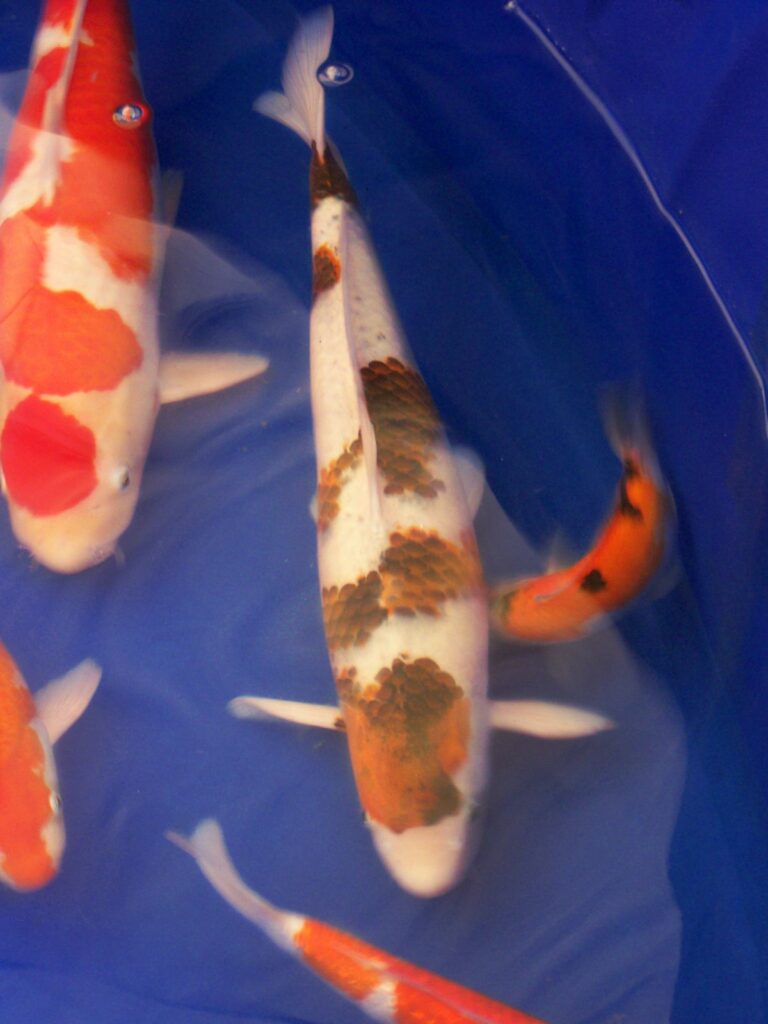
The various varieties of Koromo are the product of crossbreeding Kohaku and Asagi. “Koromo” refers to the group, while each type of Koi can go by “Koromo” or “Goromo,” depending on tradition. Koromo Koi Fish have an indigo blue crescent to the edge of the scales on their red markings. As a Kohaku based variety, an even balance of red, white, and black coloration across the body is a sign of good breeding.
- Koromo refers to ‘robes’ or ‘robed’ in the Japanese context.
- Kohaku, Taisho Sanshoku and Showa Sanshoku which have indigo tinge over-laying the red patterns are called Ai-goromo (blue garment), Koromo Sanshoku, and Koromo Showa respectively. Other varieties include Sumi Goromo and Budo Goromo.
- The blue reticulated patterns cause scales to stand out. The straighter and even the scales grow, the cleaner the Asagi markings appear. Koromo without blue scale edges are especially well favored. The blue tends to darken as the Koromo matures.
5. Tancho
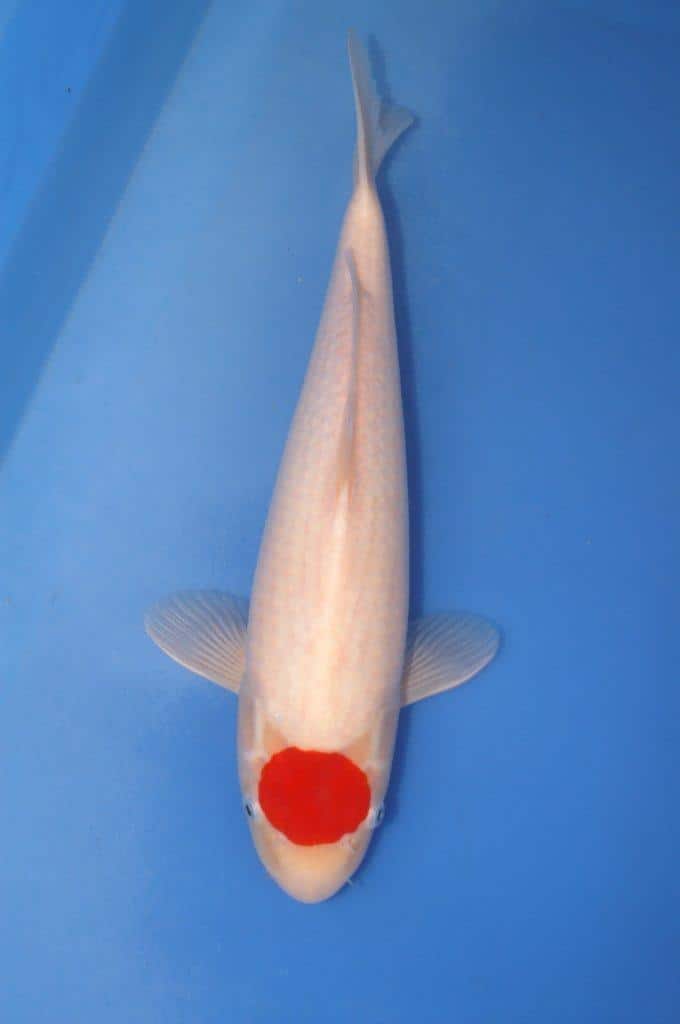
Tancho are Kohaku with pure white bodies and a single red mark on the head. Classic Tancho have a circular, vertically symmetrical red pattern. The resemblance to both the Japanese flag and the traditionally sacred Red Crowned Crane makes owning Tancho a mark of national pride. The Tancho spot can appear in other varieties but the name “Tancho” refers strictly to these white Kohaku.
- In recent times, Tancho with triangular and other shapes are considered desirable, so long as the hi is vertically symmetrical and doesn’t extend over the eyes or mouth.
- The red mark should be bright crimson with no marking within. The body should be a pure, milky white as well.
- Tancho aren’t a breedable characteristic; the placement and shape of the red mark is a matter of luck!
6. Asagi
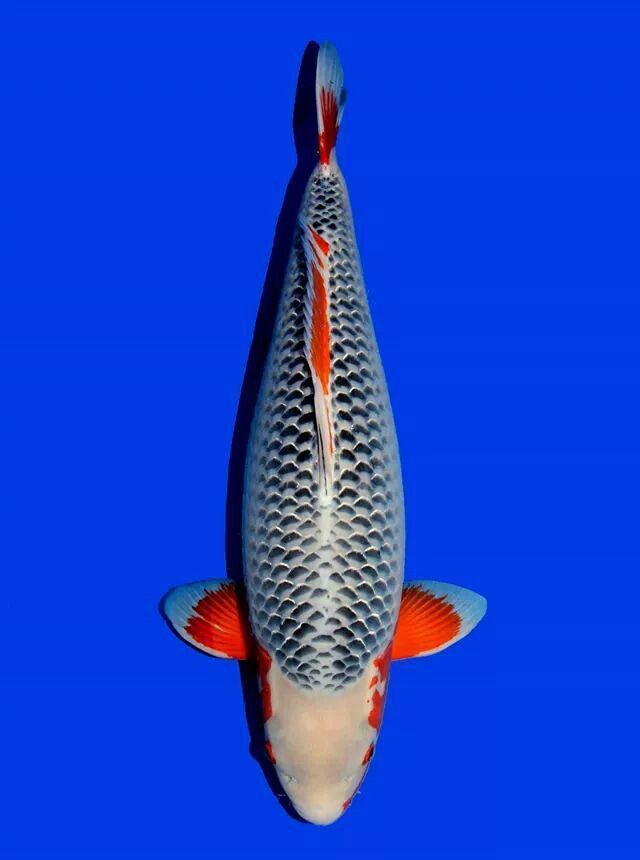
Asagi Magoi are a type of Japanese Koi Fish with blue-grey scales on their backs with a net-like pattern to scales thanks to the pale edges. One of the oldest koi varieties, Asagi have their roots in the 1860’s as descendents from wild-variety Black Carp. Below the lateral line, the scales take on a bright orange or red color that can bleed into the fins, face, and gill covers.
- Because Asagi have such well-defined scales, any missing or crooked scale patterns will be obvious, detracting from the aesthetic value of the fish.
- Top quality Asagi have heads with no orange or red. Red along the pectoral fins is called Motoaka and is favorable so long as it’s well balanced!
7. Shusui
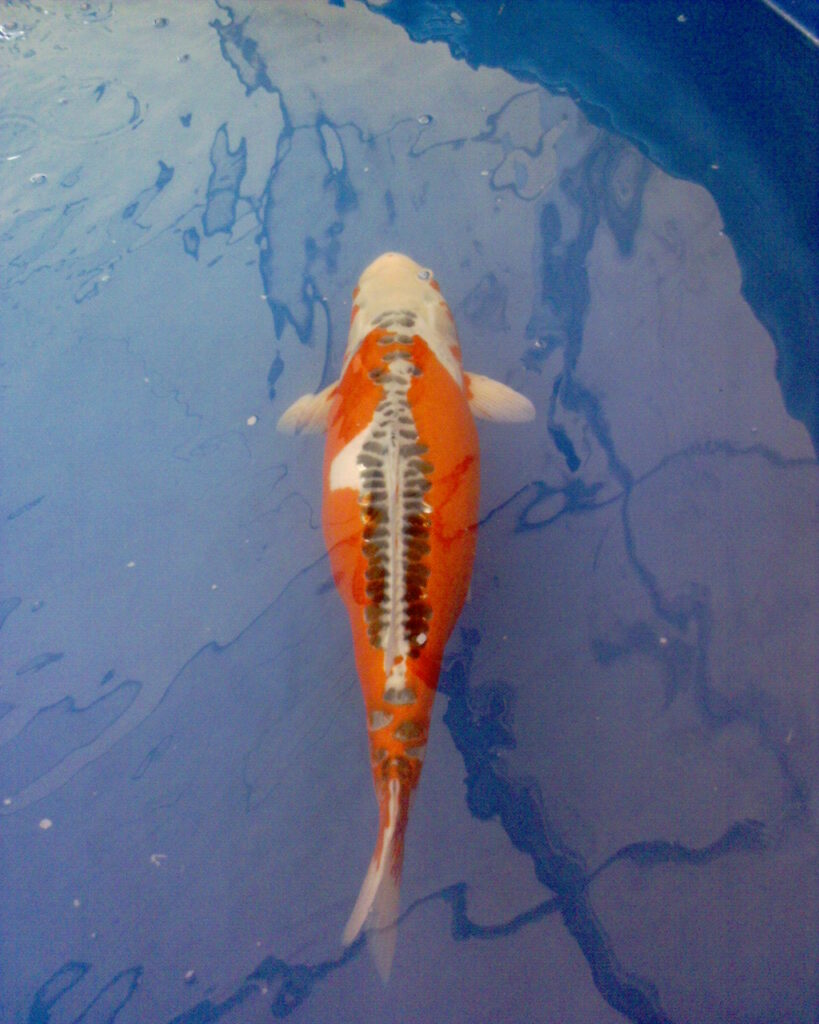
German Mirror Carp, which are mostly scaleless, were bred in the early 1900’s to provide pond-raised food fish that were easier to prepare. These German carp were imported to Japan and crossed with Asagi, resulting in the Shusui breed. The term “Doitsu” (scaleless) refers not only to Germany (Deutschland) but also describes other scaleless types of Koi fish.
- Large, even blue scales along the back are desirable in Shusui, along with an intense bluish white color.
- Red markings are also desirable (Hi Shusui).
- Shusui with mirror scales along both lateral lines are called Hana Shusui.
8. Hirenaga
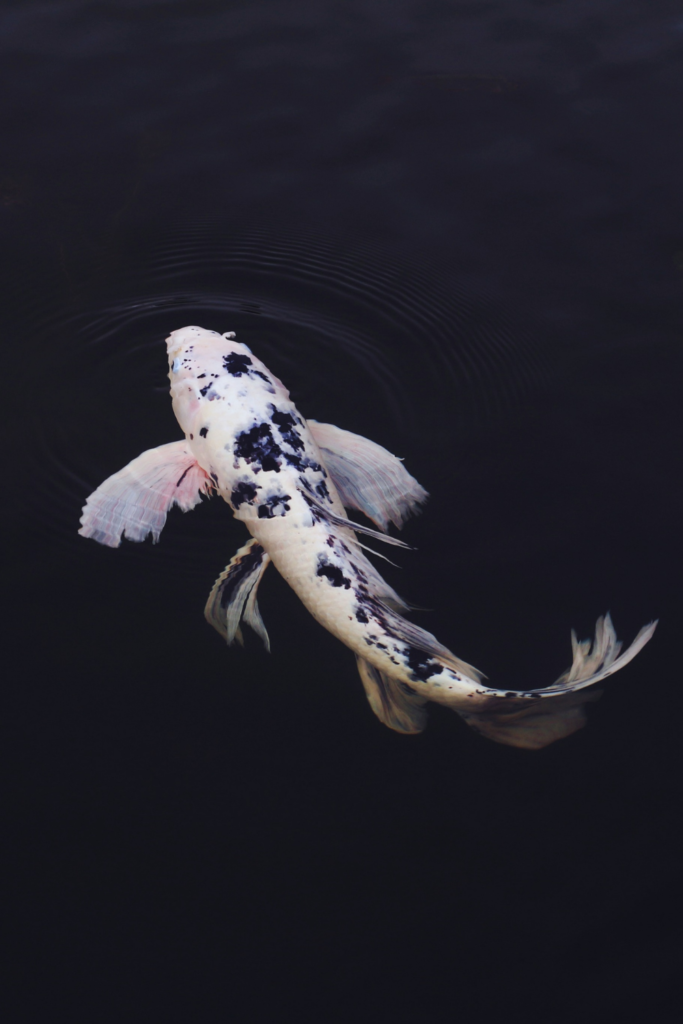
Surprisingly, even something as simple as pond fish can become controversial. Hirenaga are Koi in the sense that they’re descended from the Amur Carp. However, they are not considered Nishikigoi – “true Koi.”
Japanese breeders in the mid-20th century imported Indonesian Long-Finned River Carp to add diversity to the Nishikigoi gene pool. However, the resulting young mutts tended to manifest traits outside of the standards set by traditional Koi judging panels. Their body shapes tend to be slimmer as well with little of the robustness of Nishikigoi.
In the West, Hirenaga are often sold as butterfly koi fish! You can also see them labeled as dragon koi fish; the long fins are very reminiscent of both butterflies and dragons!
- Hirenagagoi literally means “long-finned koi” in Japanese.
- While rarely judged in competitions, Hirenaga are especially attractive when viewed from the side compared to regular Koi. They also tend to be slender and more graceful in appearance than other types of Koi.
- While not as common in Asia, Hirenaga are popular world-wide, especially in North America and Europe.
9. Utsuri
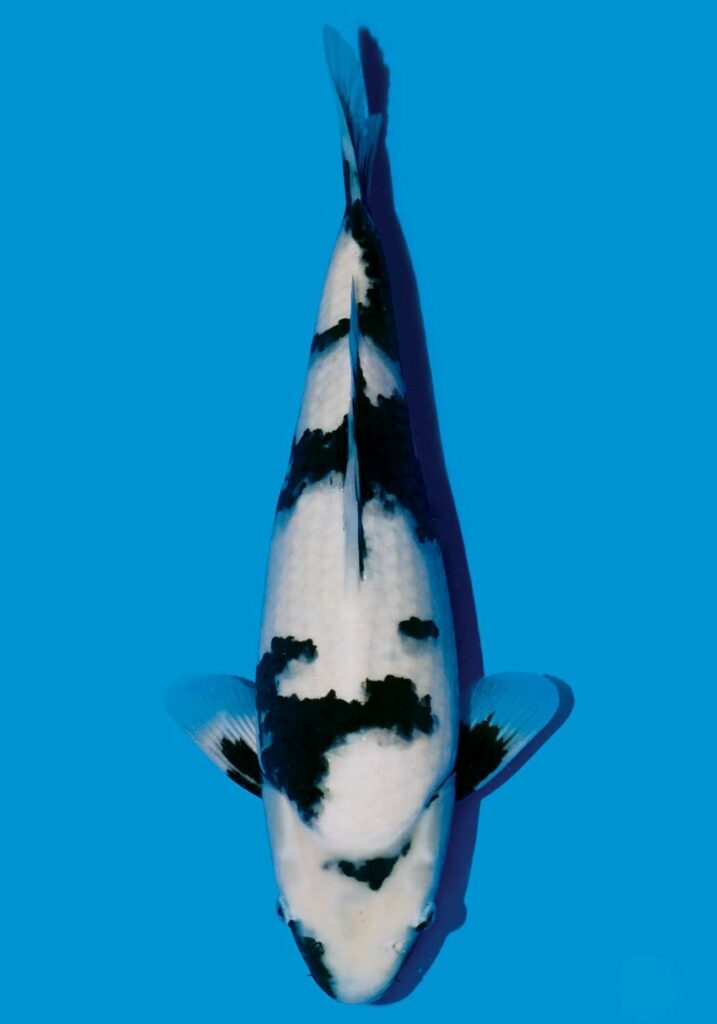
Originally of Showa Sanshoku stock, Utsuri are black-bodied with bands of black wrapping around the body. Red, white, or yellow markings of a single color are allowed and ideally well balanced across the entire body. A deep black combined with intense color for maximum contrast are the best of the breed. The name “Utsuri” means “reflection.”
- Utsuri with a face that’s half black are especially attractive in Japan.
- Hi (red), Shiro (white) or Ki (yellow) are the three varieties of show Utsuri.
10. Bekko
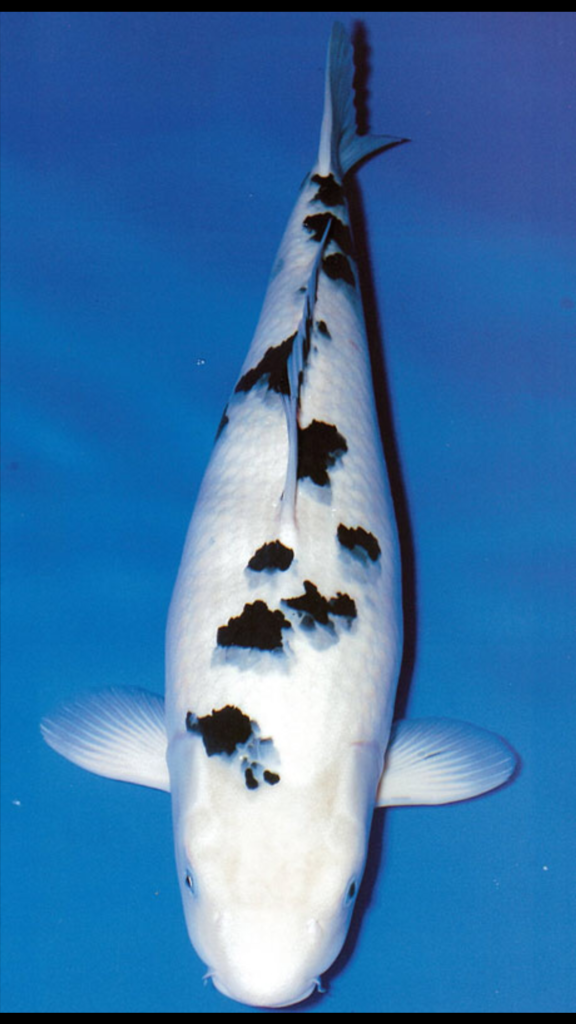
Much like Showa and Sanke, Bekko are the opposite of Utsuri. These types of Koi fish have a colored body with black sumi markings scattered across the body. Bekko can come from both Showa and Sanke stock, though Bekko with black sumi anywhere on the head are technically Showa.
- Bekko come in Aka (red), Shiro (white) or Ki (yellow) varieties.
- Like Utsuri, bold black and intense base color are ideal, along with no black sumi anywhere on the head.
11. Hikari
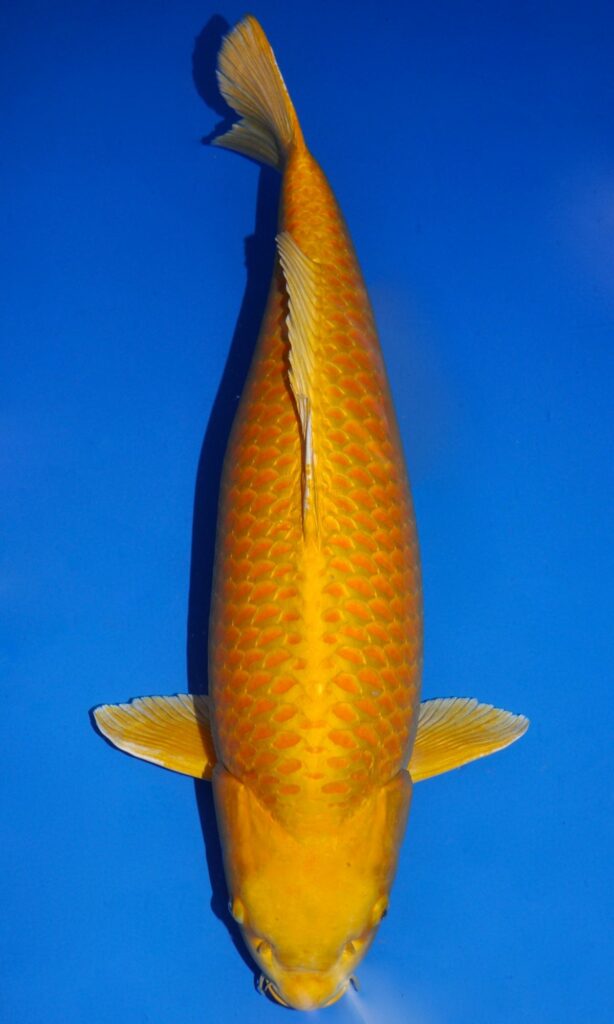
Hikari is the Japanese word for “shining,” which describes the metallic, reflective scales of Hikari Koi. In the wild, such reflective, eye-catching scales would cause them to become a quick meal but in the pond environment they are a delight to the eye. Their appearance can be likened to polished gun metal. Hikari come in three subvarieties:
- Hikarimuji: Metallic single-color Koi.
- Hikarimoyo: Metallic multi-colored Koi.
- Hikariutsuri: Metallic Koi that are also Showa or Ursiri.
12. Kumonryu
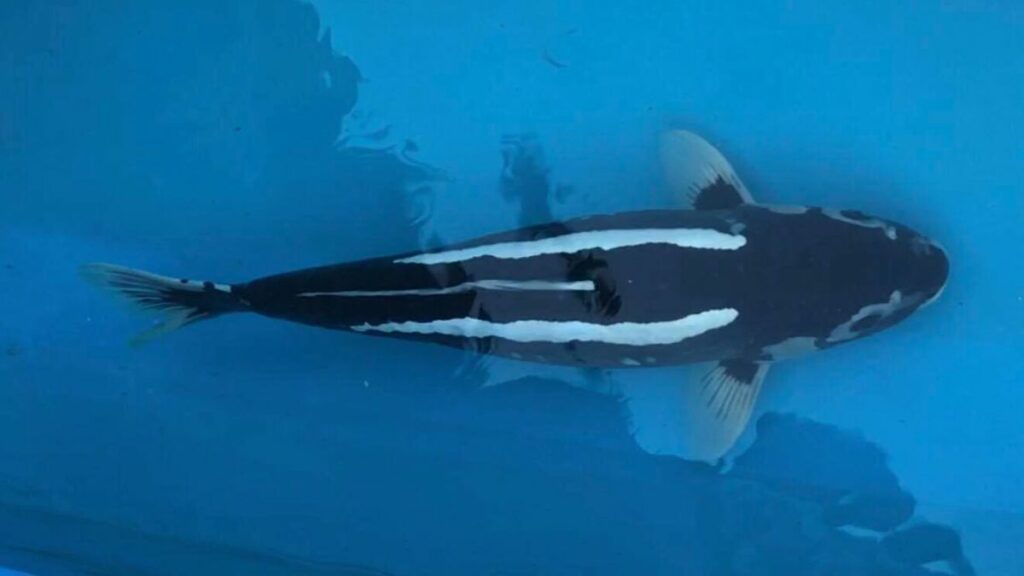
Kumonryu are Doitsu Koi Fish with a fascinating characteristic. Water quality, age, and temperature will cause Kumonryu to shift between patterns of solid midnight black, milk white, and a mixture of the two colors. These shifty types of Koi Fish are highly sought after, but their constantly changing patterns make judging them more of a challenge.
- True Kumonryu can have mirror scales but they won’t be metallic like Kikokuryu. Kikokuryu also have red markings while Kumonryu are purely black and white.
- Because both breeds constantly shift in color and pattern, choosing a Kikokuryu or Kumonryu based on its colors is a recipe for disappointment (or future surprise).
13. Matsuba
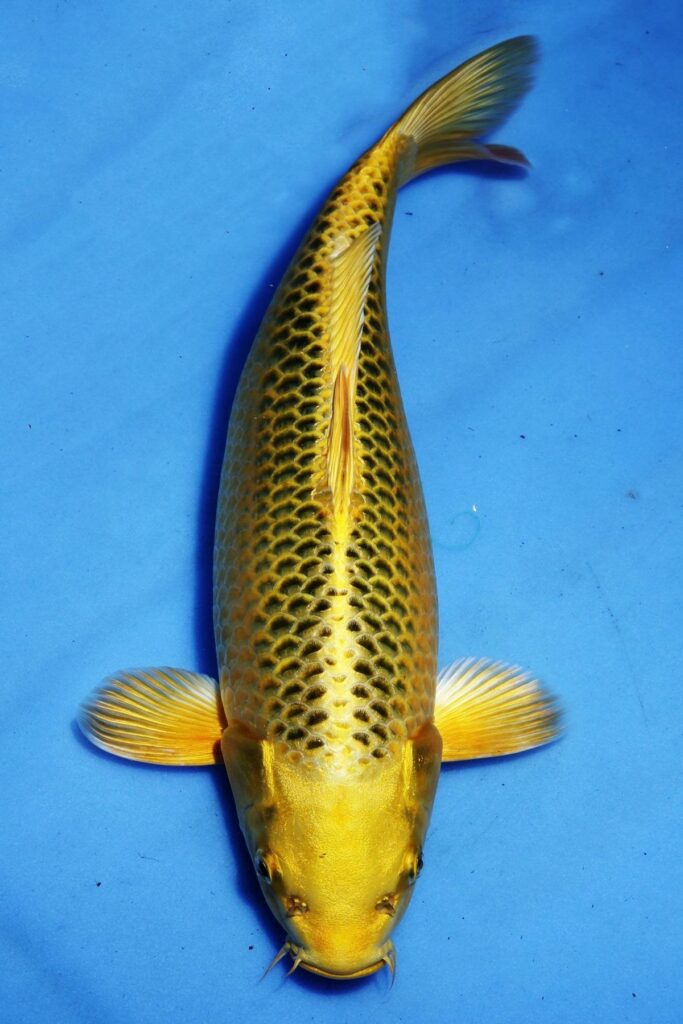
Matsuba are Hikarimuji Koi fish, so they share the metallic color of this breed. However, they also have dark centers to their scales that form a strong reticulated pattern. Some such as Kin (Gold) Matsuba and Gin (Silver) Matsuba look similar to a pine cone from above. The Orenji (deep orange) Matsuba mixes light and dark orange into an intensely colored pattern.
- Doitsu Matsuba are the only recognized variety; they are scaleless except for mirror scales that have the same reflective outer and dark inner region as other Matsuba.
14. Purachina and Yamabuki Ogon
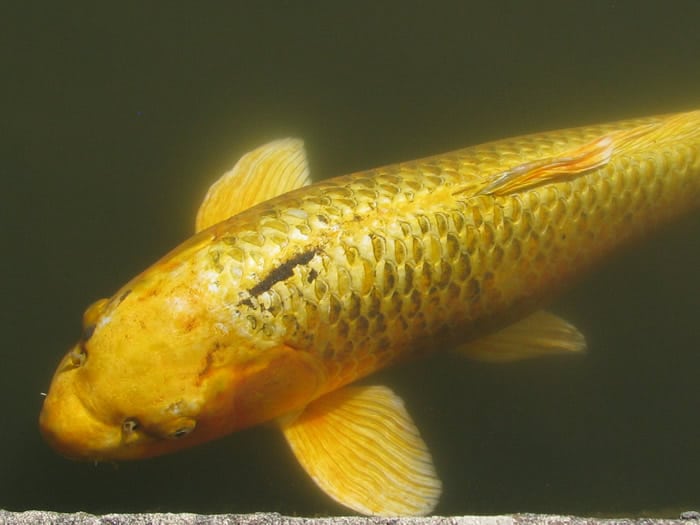
Purachina (Platinum) and Yamabuki (Gold) Ogon are also popular Hikarimuji types of Koi Fish. Purachina Ogon have solid white or silver bodies while Yamabuki Ogon are yellow or golden colored. A clear, unmarked white head and body free of markings are ideal in these Nishikigoi. Butterfly Ogon are often seen in stores and are some of the most graceful Koi on the market but aren’t favored by purists.
- All Ogon are solid metallic silver or gold Koi.
- Ogon also come in Doitsu or Gin Rin varieties.
15. Kawarimono
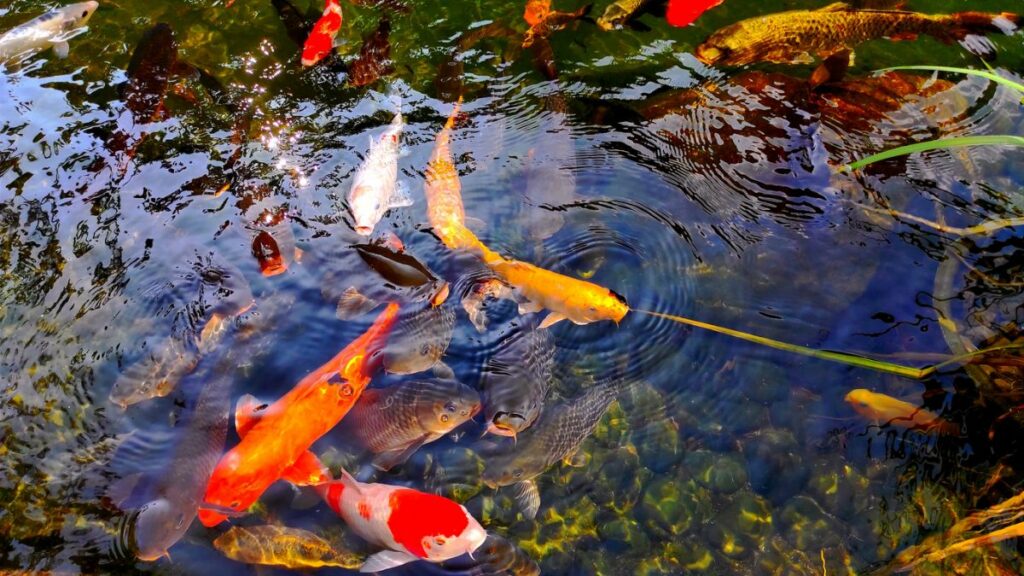
Kawarimono is a catch-all term for nonmetallic types of Japanese Koi Fish not considered standard color morphs like Kohaku or Matsuba. While grouped together, Kawarimono can still compete in shows and breeds come and go from the categorization. Kumonryu and Kikokuryu are part of this group, despite being desirable Koi.
- Catch-all term for many types of Koi fish.
Many of the judging qualifications for other Nishikigoi also apply to Kawarimono, including well balanced coloration and scale formation.
How to Take Care of Koi Fish
Taking care of koi fish is not especially complicated. So long as you can afford to give them plenty of space and cool water conditions your koi fish should live for decades!
What Do Koi Fish Eat?
Japanese koi fish are like goldfish and other carp; they are omnivorous! In nature, koi fish eat worms, algae, snails, soft aquatic plants, shrimp, fish eggs, and anything else that they find along the bottom of ponds.
This willingness to eat anything organic in a pond is another reason why keeping koi fish outside is such a good idea! There are plenty of things that will grow in a pond that will give your koi fish some diversity in their diet. Insect larvae and other treats will be highly appreciated by them!
However you still need to keep a high quality prepared food formula on hand at all times. Since koi fish are so big you can’t really feed them flakes. Instead, you will want to offer them a pellet-based formula.
By the way, there are two blends of koi food that should be used, depending on the time of year. In the warm season, koi fish can be fed standard koi pellets. But when fall has arrived and winter is approaching, you will want to feed a winter formula, which uses easily digestible wheat germ.
This is so if the koi fish happens to slip into hibernation with a full belly the food won’t sit inside their stomachs for too long. Undigested food can cause bloating as it rots, which can be fatal to the koi fish.
How Big Do Koi Fish Get?
Make sure that you are willing to give your koi fish enough space as they grow because they do get very big! When fully grown, koi fish mature at between 24 and 36 inches. They grow fairly quickly at around ¾ to 1 inch per month, slowing down as they approach their final adult size.
Overall, the specific type of koi fish does not matter when it comes to how big koi fish get. Some may be a little fatter or slimmer; dragon koi fish tend to be trim compared to other types of koi fish. However, they all reach 2 to 3 feet long when fully grown!
How Fast Do Koi Fish Grow?
They grow fairly quickly at around ¾ to 1 inch per month, slowing down as they approach their final adult size. For such large fish, koi fish grow quite quickly!
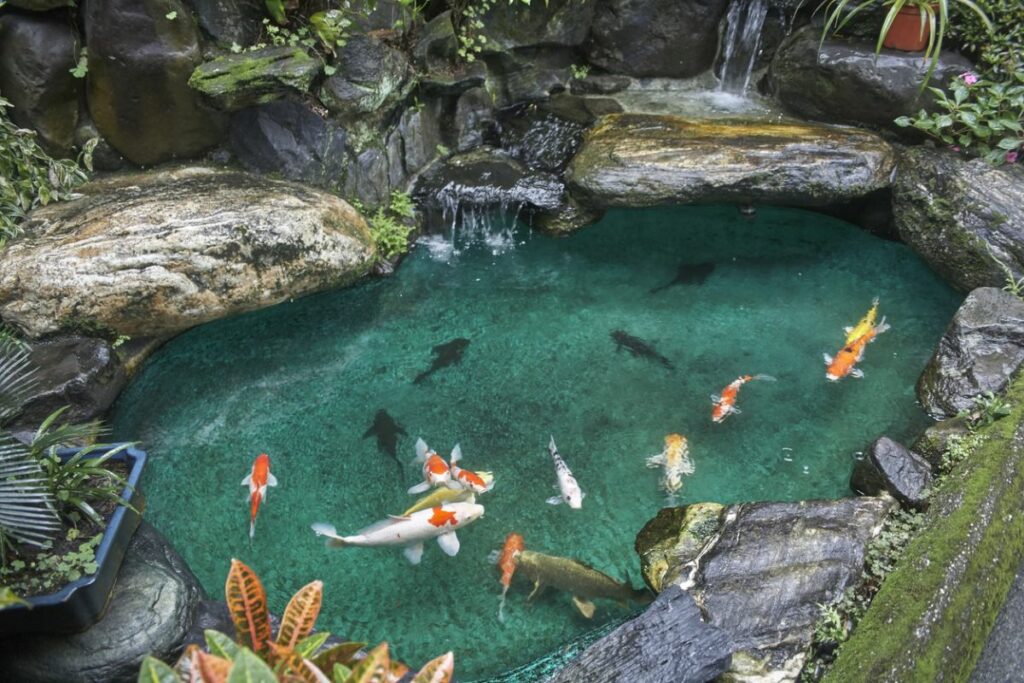
Can Koi Fish Live in a Tank?
So can koi fish live in a tank? The answer is yes – but it is not a very economical idea. Koi fish get so large (up to 3 feet long) that you would need to buy a custom built – and therefore, very expensive – koi fish tank.
A koi fish pond is by far the best environment for your full grown koi fish! In a koi fish pond they have room to grow, turn around easily, and they can overwinter in all but the coldest of climates.
But if you simply must have a koi fish in an aquarium then you will need something hundreds of gallons in volume. A round indoor tank would be even better so your adult koi fish can turn around in an easy manner.
How Much are Koi Fish?
Believe it or not, koi fish can be some of the most expensive fish in the world! Most pond koi fish for sale are not too expensive at all. Generally, you can find cheap koi fish for sale as little as $5 to $10 when very small. These may be mutts like unidentified black koi fish. Or they might be identifiable breeds such as butterfly koi fish.
But these koi fish cost little compared to most of the types of koi in the list below! Because the higher the quality the more expensive koi fish for sale are. A high quality Asagi or Kikokuryu koi fish can run $1000 or more, for example. But the S Legend Kohaku koi fish, sold in 2018, went for $1.8 million dollars!
Even good quality kohaku that aren’t full grown breeders tend to be expensive. Medium sized (10-14 inch) decent to good quality Kohaku koi fish cost anywhere from $200 to $9000 dollars!
Why are Koi Fish so Expensive?
Koi fish are so expensive because they are popular and breeding them is an intensive effort. Also koi fish are a symbol of national pride for Japan, in particular. So getting high quality types of koi fish can often mean spending a lot of money.
This is because it takes a lot of money for the best koi fish food, living conditions, and access to fully grown koi fish of the best bloodlines. High quality koi fish can even have pedigrees, like horses and dogs, tracing their lineages back generations. All of this means that there is a huge amount of money in koi fish breeding!
Fortunately, you don’t have to have the highest quality Shushui blue koi fish or Showa Sanshoku black koi fish to enjoy them. In fact, the mixed patterns of koi fish mutts are endless in variety and can be even more enjoyable than watching purebred koi parade around your pond!
Where Can I Buy Koi Fish?
Unfortunately, it’s true – koi fish can be a little pricey. But not all koi fish cost an arm and a leg! If you are trying to decide where to buy koi fish near me, you may have some trouble if you aren’t near a major city. And what few koi fish are near you are likely of poor quality and not in very many colors compared to what is truly available.
So where to buy koi fish for sale that are high quality and affordable? I recommend the internet; believe it or not, buying goldfish and koi fish online has never been easier! You will typically choose the fish you want and they will show up at your door in 2 to 3 business days. Since they are packed with plenty of oxygen and thrive in cool conditions, koi fish are very easy to ship.
Buyers of more expensive koi fish can often see the exact fish online thanks to high resolution photos or even videos!
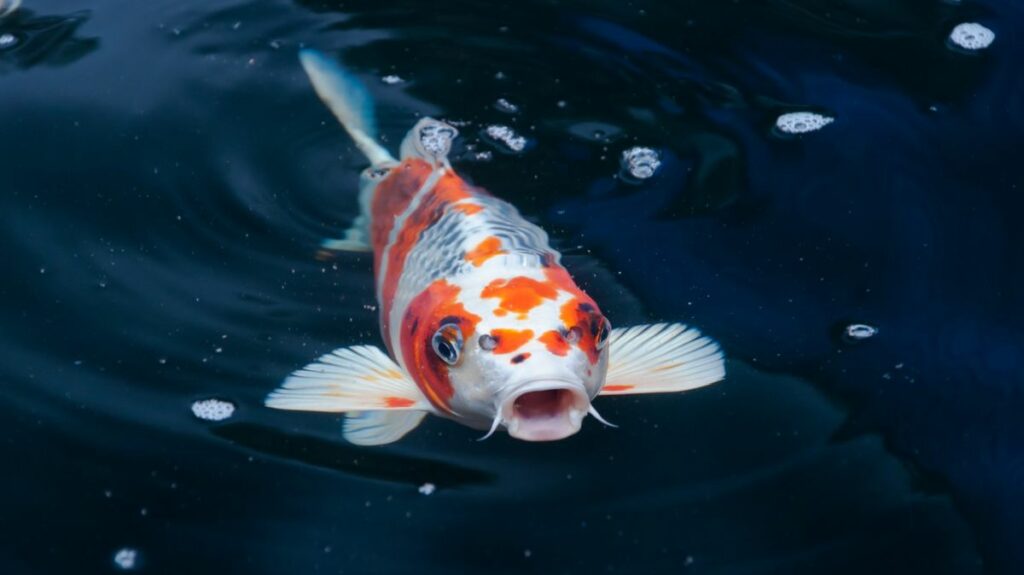
What Do Koi Fish Represent?
Koi fish symbolism is a very real thing! In Japan, the koi fish meaning has to do with luck and prosperity. They are also seen as a national cultural symbol since they were first domesticated in Japan. Koi fish are also associated with perseverance, since the fish will do whatever it takes to fight currents in order to spawn.
The associations with luck, perseverance, and prosperity are why koi fish tattoos, koi fish paintings, and koi fish drawings are so popular! And as koi fish have spread, the positive koi fish meanings have also followed along with them. You also see many more Japanese koi fish tattoos, koi fish paintings, and koi fish drawings in countries other than Japan as a result of this spread!
How Long Do Koi Fish Live?
Koi fish are some of the longest lived fish – not just in the pet trade but in the entire world! 40 to 60 years is entirely normal for an adult koi fish that is well cared for. However there are many verified instances of koi fish living even longer.
Hanako is a world-famous koi fish that was dated to have been between 215 and 226 years of age when she died. The poor quality of mixed breed koi, especially koi fish kept in poor conditions, can impact their lifespan.
Still, even a very average koi will live for decades. Any koi fish that you buy should be thought of as a long-term investment!
Other Frequently Asked Questions about Koi Fish
Koi fish meaning is extremely relevant in East Asian countries, especially their homeland of Japan. Koi are associated with luck, prosperity, and perseverance. After all, it is usually an affluent person that has the money, space, and time to dedicate to koi fish care!
As koi fish have spread around the world, the representations they hold have also spread with koi fish ponds!
Yes, you can eat koi fish! In fact, koi fish were originally raised for food in East Asian countries. It was only after a few beautiful specimens appeared that people started raising them for color and prestige.
Koi fish is like any other carp; a bit muddy and not as firm as the white fish that are preferred in Western countries. But when cooked with the right spices and preparation they can be quite delicious!
Goldfish are very closely related to koi fish; in fact the two can even interbreed. But goldfish are a separate species (Carassius auratus) from koi fish (Cyprinus rubrofuscus). Goldfish are also much smaller when fully grown. But you can keep goldfish in a koi fish pond because they eat the same kinds of food and get along very well with koi fish!

